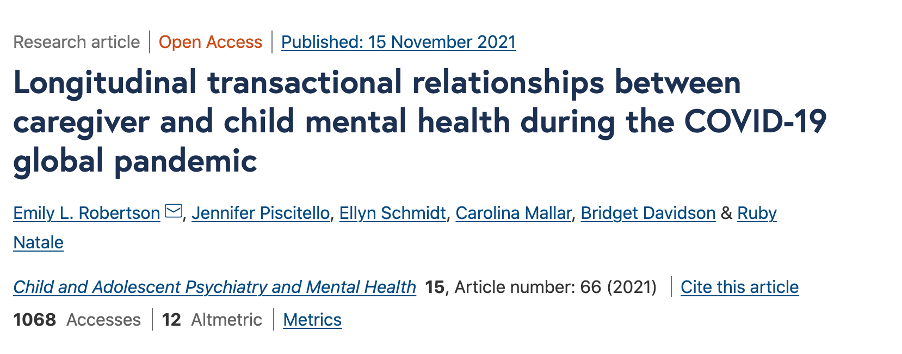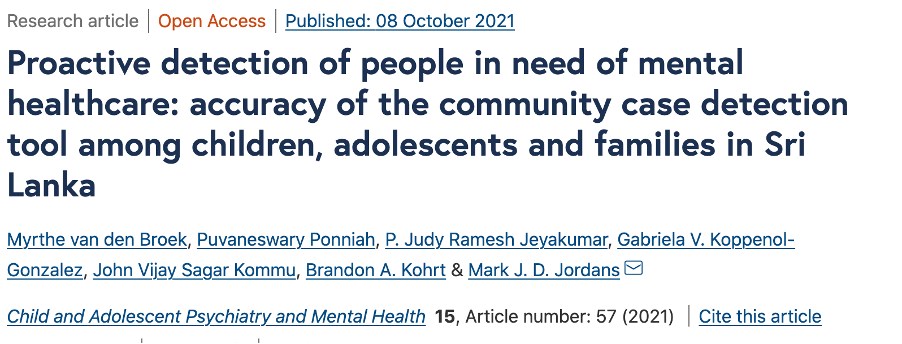CAPMH Corner (Updated Mar 2022)
By: Lakshmi Sravanti, India, Associate Editor, CAMPH
Child and Adolescent Psychiatry and Mental Health (CAPMH) is the official IACAPAP Journal. The "CAPMH Corner" of the March 2022 issue summarizes the following three studies – coping and psychological resilience in Australian adolescents during the COVID-19 pandemic (Beames et al., 2021), longitudinal transactional relationships between caregiver and child mental health during the COVID-19 global pandemic (Robertson et al., 2021), and proactive detection of people in need of mental healthcare using a community case detection tool from Sri Lanka (van den Broek et al., 2021a).
Beames et al., (2021) underscore the need to understand how adolescents have coped with the COVID-19 pandemic and factors that support adaptive success to facilitate disaster planning by optimising social resources. They also state that there is limited data on individual differences in resilience and relationship between resilience and positive and negative experiences of young people during the pandemic. They conduct a large cross-sectional, mixed methods online survey to explore resilience, positive experiences and coping strategies in Australian adolescents during the COVID-19 pandemic.
The team recruits 760 young people aged between 12 and 18 years by convenience sampling through established networks within the Black Dog Institute. They collect the demographic and mental illness history of the participants. In addition, they assess them using the 10-item Connor-Davidson Resilience Scale (CDRISC-10), the Kessler-6 (K6), and a bespoke questionnaire (developed by them for the current study to assess positive experiences during COVID-19). They ask the subjects to write free text responses to one open-ended question that enquired about coping strategies used during the pandemic. They conduct simultaneous multiple regression analysis and binary logistic regression analysis to study the relationships between demographic characteristics and resilience, and resilience and psychological distress respectively. A team member codes responses to an open-ended question on coping strategies using a deductive approach as part of qualitative analysis.
Majority (72%) of the sample were female. Almost half of the sample experienced psychological distress indicative of probable mental illness. Participants who identified as female or as non-binary or another gender reported significantly lower resilience levels than those who identified as male. Individuals with a history of mental illness reported significantly lower resilience compared to those without a mental illness history. Mental illness history was more strongly related to resilience compared to age and gender. Increased resilience was associated with positive experiences. Over half of the sample (56.9%) reported feeling greater levels of empathy toward others who are less fortunate than themselves, and 42.9% reported feeling more grateful in general. Majority (78.42%) of the subjects provided a response to the open-ended question enquiring about coping strategies. Coding of free-text responses yielded 14 categories of active coping strategies and two categories of passive coping strategies. Almost 80% of responses were noted to be helpful coping mechanisms. The most common coping strategies employed were active – socialising (37.89%), engaging in hobbies (24.4%), and doing physical exercise (12.63%).
Authors conclude that resilience and distress are important targets for psychological intervention in youth during public health emergencies such as pandemics. In view of the methodological limitations such as – cross-sectional nature of the study, the possibility of selection bias and response bias, exclusive focus on internalizing symptoms, and lack of multiple informants, they recommend future prospective longitudinal resilience studies addressing the same and evaluating multiple developmental systems to document cascading consequences. They suggest additional areas for future research such as effects of gender on vulnerability to and recovery after stressful life events and positive experiences and resilience.
Robertson et al., (2021) discuss the cascading effects of the ongoing pandemic on the mental health of parents and children. They highlight that research evaluating the impact of the ongoing pandemic on the functioning of families done so far has been unidirectional or cross-sectional in design. Thus they establish a need to study the transactional relationship between caregiver and child stress and mental health over time to construct empirically informed models of pandemic-related functioning and inform intervention strategies.
The team sets out to examine the bidirectional relationship between pandemic-related stress and caregiver mental health and child behavior (i.e. internalizing, externalizing and prosocial behaviours) at three timepoints over four months following the stay-at-home-order issued after the COVID-19 outbreak. They recruit 286 (racially, ethnically and linguistically diverse) caregivers of young children (260 from email lists of caregivers participating in service programs offered at a university medical centre located in the South-eastern United States who completed the survey online and 26 through a community-based participatory research approach). They assess the participants using a Risk and Resilience Survey (developed by the team to assess family functioning), Everyday Stressors Index (ESI), and selected items from the Experiences Related to COVID-19 Questionnaire. They use the Strengths and Difficulties Questionnaire (SDQ) to evaluate the psychological attributes of children. They construct a series of autoregressive cross-lagged path models to test the relationship between the variables across time and use root mean square error of approximation (RMSEA), comparative fit index (CFI) and Tucker-Lewis index (TLI) to estimate the model fit.
Authors report that impaired caregiver mental health at Time 1 predicted worse future pandemic-related stress at Time 2. In addition, impaired caregiver mental health at Time 2 predicted worse child externalizing symptoms at Time 3. Caregiver pandemic-related stress at Time 1 predicted increases in child internalizing symptoms at Time 2, that in turn, predicted increases in caregiver pandemic-related stress at Time 3. Both child internalizing and externalizing were negatively correlated with child prosocial behavior. They suggest that interventions targeting caregiver mental health concerns and stress are likely to reduce the risk of externalizing problems and distress in their children, respectively; and reducing children’s worry and distress may decrease the compounding and co-occurring caregiver stress.
The team concludes that interventions targeting multiple levels – caregiver, the child, and/or the family should be considered to interrupt potential negative developmental cascades. They acknowledge various limitations of their study and recommend replicating the current study in a clinical sample and outside of the US (to understand potential cultural differences), and future research to assess caregiver-child attachment as a mediator or moderator between caregiver and child functioning (in the context of the current disaster); examine the impact of interventions targeting caregiver stress and children’s internalizing symptoms on the symptoms and study the relationship of resilience in parents to resilience in children.
van den Broek et al., (2021a) note various barriers to seeking help for mental health ailments especially among children and adolescents in conflict-affected low- and middle-income countries (LMICs). They emphasize that under-detection of children and families in need of mental healthcare is one of the important factors contributing to the wide treatment gap. They conduct a study to assess the accuracy of a new method to overcome some of the demand-side barriers by supporting community-level proactive detection of children, adolescents and families in need of mental healthcare in Sri Lanka.
The team assesses the accuracy of a child-focused Community Case Detection Tool (CCDT) that identifies children and adolescents aged 6-18 years and families in need of mental healthcare to encourage help-seeking (van den Broek et al., 2021b). Given the crucial role that family functioning plays on children’s mental health, they add an additional vignette to the tool that assesses family-level problems. They use an abbreviated version of the Ten Questions Screen for Childhood Disability (TQS) to screen the participants for assess hearing, speaking, or severe cognitive disabilities prior to participation in the study; an adapted version of the Safe Environment for Every Kid—Parent Questionnaire-R (SEEK PQ-R) to evaluate family problems and child protection needs; the Indian Tamil MINI-KID 6.0 to evaluate the mental health of children and adolescents the gatekeepers had detected; and the Sri Lankan Tamil parent version of the Strengths and Difficulties Questionnaire (SDQ) to assess the concurrent validity of the CCDT positives. The senior counsellor administering the MINI-KID and SEEK PQ-R answers a concluding dichotomous question regarding the indication for psychological treatment from a mental health professional.
One of the team members who is a master trainer trains a supervising psychiatrist (and a backup psychiatrist) to administer MINI-KID, who subsequently trains five senior community counsellors to use MINI-KID and SEEK PQ-R. Supervision meetings are held with the counsellors to ensure quality control and provide support with referrals. Ten research assistants receive training in research basics required for this study and community gatekeepers participate in a 2-day training program by a research coordinator. Community gatekeepers (n=45) are all female and older than 18 years. They include youth club leaders, women society group members and community health volunteers. They use the CCDT regularly for six months and detect a total of 238 children aged 6–18 years. To minimize confirmation bias, direct contact between gatekeepers and counsellors is limited and the CCDT probable negatives were invited to participate in the study.
The average age of the sample was 12.3 years with an equal distribution of girls and boys. Of the 157 CCDT probable positives, 109 were indicated for mental health treatment. Authors record that community gatekeepers can accurately detect two out of three children and families in need of mental healthcare using the CCDT. The performance of the CCDT was comparable with the SDQ. Therefore, it can serve as an alternative scalable method to universal screening for mental health problems. The team could not evaluate gender differences in the results as all the community gatekeepers were female. They mention that future research can explore this and also will focus on the development and evaluation of an additional “help-seeking encouragement strategy” component of the CCDT.
References
Beames, J.R., Li, S.H., Newby, J.M. et al. The upside: coping and psychological resilience in Australian adolescents during the COVID-19 pandemic. Child Adolesc Psychiatry Ment Health 15, 77 (2021). https://doi.org/10.1186/s13034-021-00432-z
Robertson, E.L., Piscitello, J., Schmidt, E. et al. Longitudinal transactional relationships between caregiver and child mental health during the COVID-19 global pandemic. Child Adolesc Psychiatry Ment Health 15, 66 (2021). https://doi.org/10.1186/s13034-021-00422-1
van den Broek, M., Ponniah, P., Jeyakumar, P.J.R. et al. Proactive detection of people in need of mental healthcare: accuracy of the community case detection tool among children, adolescents and families in Sri Lanka. Child Adolesc Psychiatry Ment Health 15, 57 (2021a). https://doi.org/10.1186/s13034-021-00405-2
van den Broek, M., Hegazi, L., Ghazal, N., Hamayel, L., Barrett, A., Kohrt, B.A., Jordans, M.J.D. Accuracy of a proactive case detection tool for internalizing and externalizing problems among conflict-affected children and adolescents. J Adolesc Health (2021b). https://doi.org/10.1016/j.jadohealth.2021.03.011




